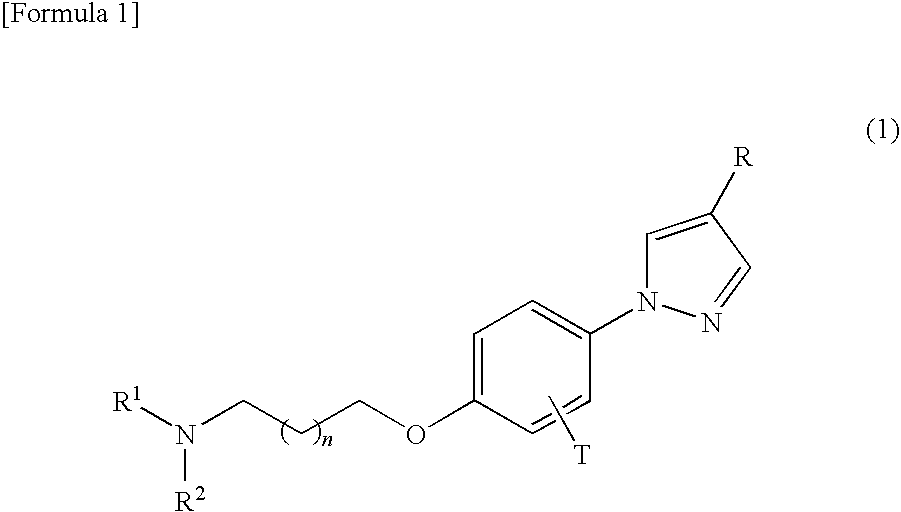Phenylpyrazole derivatives
a technology of phenylpyrazole and derivatives, which is applied in the field of phenylpyrazole derivatives, can solve problems that have not yet been developed, and achieve the effect of excellent histamine h3 receptor antagonists
- Summary
- Abstract
- Description
- Claims
- Application Information
AI Technical Summary
Benefits of technology
Problems solved by technology
Method used
Image
Examples
example 1
Preparation of 1-(4-{3-[(2R)-2-methylpyrrolidin-1-yl]propoxy}phenyl)-1H-pyrazole-4-carboxylic acid ethyl ester
(1) Preparation of 1-(3-chloropropoxy)-4-iodobenzene
[0288]
[0289]To a solution of 4-iodophenol (20.0 g) and 1-bromo-3-chloropropane (18.6 g) in 2-butanone (200 mL), potassium carbonate (25.1 g) was added and stirred at 100° C. for 5 hours. The reaction mixture was cooled to room temperature, diluted with water and extracted with ethyl acetate. The organic layer was washed with water and brine, dried over sodium sulfate and concentrated under reduced pressure to give the titled compound (28.4 g) as an orange-colored oil.
(2) Preparation of (2R)-1-[3-(4-iodophenoxy)propyl]-2-methylpyrrolidine
[0290]
[0291]A suspension of 1-(3-chloropropoxy)-4-iodobenzene obtained in Example 1-(1) (2.79 g), (R)-2-methylpyrrolidine (0.961 g), sodium iodide (0.282 g) and potassium carbonate (2.60 g) in acetonitrile (2.8 mL) was stirred in a sealed tube at 100° C. for 5 hours. The reaction mixture was...
example 2
Preparation of 1-(4-{3-[(2R)-2-methylpyrrolidin-1-yl]propoxy}phenyl)-1H-pyrazole-4-carboxamide
(1) Preparation of 1-(4-{3-[(2R)-2-methylpyrrolidin-1-yl]propoxy}phenyl)-1H-pyrazole-4-carboxylic acid hydrochloride
[0296]
[0297]To 1-(4-{3-[(2R)-2-methylpyrrolidin-1-yl]propoxy}phenyl)-1H-pyrazole-4-carboxylic acid ethyl ester obtained in Example 1-(3) (1.11 g), concentrated hydrochloric acid (7.0 mL) was added at room temperature and stirred at 80° C. for 2 hours. The reaction mixture was concentrated under reduced pressure to give the titled compound (1.08 g) as a light-brown solid.
(2) Preparation of 1-(4-{3-[(2R)-2-methylpyrrolidin-1-yl]propoxy}phenyl)-1H-pyrazole-4-carboxamide
[0298]
[0299]To a suspension of 1-(4-{3-[(2R)-2-methylpyrrolidin-1-yl]propoxy}phenyl)-1H-pyrazole-4-carboxylic acid hydrochloride obtained in Example 2-(1) (1.08 g) in N,N-dimethylformamide (11 mL), 1-hydroxybenzotriazole monohydrate (0.539 g) was added at room temperature and stirred for 5 minutes. To the reaction ...
example 3
Preparation of 1-(4-{3-[(2R)-2-methylpyrrolidin-1-yl]propoxy}phenyl)-1H-pyrazole-4-carbonitrile
[0302]
[0303]To a solution of 1-(4-{3-[(2R)-2-methylpyrrolidin-1-yl]propoxy}phenyl)-1H-pyrazole-4-carboxamide obtained in Example 2-(2) (0.466 g) in N,N-dimethylformamide (5.0 mL), thionyl chloride (1.0 mL) was added dropwise under ice cooling and stirred at 0° C. for 30 minutes. The reaction mixture was adjusted to pH 8 by addition of water and saturated aqueous sodium bicarbonate, and then extracted with ethyl acetate. The organic layer was washed with brine, dried over sodium sulfate and concentrated under reduced pressure. The resulting residue was purified by silica gel column chromatography (eluting solvent: n-hexane:ethyl acetate=1:1), and the resulting crystal was washed with hexane:diisopropyl ether (1:1) to give the titled compound (0.253 g) as a colorless solid.
[0304]1H NMR (600 MHz, CHLOROFORM-d) δ ppm 1.08 (d, J=6.0 Hz, 3H), 1.37-1.46 (m, 1H), 1.65-1.83 (m, 2H), 1.88-2.06 (m, 3...
PUM
 Login to View More
Login to View More Abstract
Description
Claims
Application Information
 Login to View More
Login to View More - R&D
- Intellectual Property
- Life Sciences
- Materials
- Tech Scout
- Unparalleled Data Quality
- Higher Quality Content
- 60% Fewer Hallucinations
Browse by: Latest US Patents, China's latest patents, Technical Efficacy Thesaurus, Application Domain, Technology Topic, Popular Technical Reports.
© 2025 PatSnap. All rights reserved.Legal|Privacy policy|Modern Slavery Act Transparency Statement|Sitemap|About US| Contact US: help@patsnap.com



